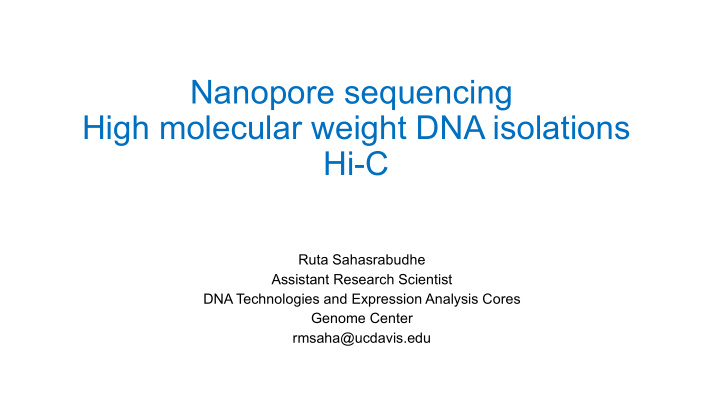



Nanopore sequencing High molecular weight DNA isolations Hi-C Ruta Sahasrabudhe Assistant Research Scientist DNA Technologies and Expression Analysis Cores Genome Center rmsaha@ucdavis.edu
Oxford nanopore sequencing How it works
Oxford nanopore sequencing Long read sequencing In theory read length is limited by the length of input DNA Simpler workflow Robust equipment Sequencer hardware is electronics highly scalable Lower cost per bp sequence Higher rates of not-fully random errors
ONT sequencing platforms available in the DNA Tech Core PromethION MinION - portable sequencer Low throughput High throughput Can run single flowcell at a time Can run up to to 24 flowcells at a time 2-10 Gbp yield per flowcell 20-90 Gbp yield per flowcell
Sample preparation kits Ligation Sequencing kit Rapid sequencing kit
Different types of workflows available for DNA sequencing with ONT platforms Super long read sequencing – HMW DNA > 50Kb in length, PromethION flowcell yield range from 20 Gbp to 90 Gbp, read length N50 ~30 Kb, can generate reads >200 kb in length Long read sequencing – DNA 5Kb to 20Kb in fragment length, yield per flowcells can range from 20 Gb -100 Gbp, read length N50 10Kb
Example of a good PromethION run Mbp sized gDNA 50Kb shear 48Kb 20KB 10KB Good quality DNA isolated from cultured mammalian cell lines or blood sample can generate up to 90Gbp of data with read length N50 of 30Kb
Example of an OK PromethION run Read length N50=13Kb 48Kb Beautiful killifish but so so DNA Killifish DNA
Different types of workflows available for DNA sequencing with ONT platforms Super long read sequencing – HMW DNA > 50Kb in length, PromethION flowcell yield range from 20 Gbp to 90 Gbp, N50 can reach up to 33 Kb, longest reads >200 kb in length Long read sequencing – DNA 5Kb to 20Kb in fragment length, yield per flowcells can range from 20 Gb -100 Gbp, read length N50 10Kb Ultra-long-read DNA sequencing
Ultra-long-read DNA sequencing Mbp sized gDNA Read length N50=70Kbp 15-20µg + + 48Kb MinION Rapid chemistry Available only on MinION, lower yields ( 1Gb – 2Gb)
Factors influencing sequencing yield and run matrices Sample quality samples should be free of any contaminants such as salt, EDTA, protein, organic solvents DNA damage will negatively influence the run Certain species perform worse than other Is there something fishy with bird DNA? cnidaria, marine life, birds Nanopore is working on updated protocols for these difficult samples Flowcell quality Number of active pores on a PromethION flowcell can range from 5000 to >9000
Input DNA requirement for nanopore sequencing • Good quality, high molecular weigh DNA >50Kb in length • Free of contaminants such as polysaccharides, proteins, salts, etc • Nanodrop ratio of 260/280=1.8 260/230=2.0 • >5µg input
cDNA and direct RNA sequencing Direct RNA sequencing 100ng -2µg total RNA Needs >500ng poly A RNA (~50µg of total RNA? or more ) > 50 million reads Yield 1-4 Gbp Only on MinION Can detect RNA modifications
High molecular weight DNA isolation
High molecular weight DNA isolation Spin column based methods not suitable Animal cells and tissue Going back to old school, modified Sambrook and Russell protocol Protein salting out Plant tissues CTAB Qick et al, protocols.io Nuclei enrichment
Starting material for HMW DNA extractions • Cultured cell lines • Whole blood or white blood cells • Soft cellular tissue • Insect pupae • Young leaves, etiolated tissues
Starting material for HMW DNA extractions • Cultured cell lines Works very well! • Whole blood or white blood cells • Soft cellular tissue • Insect pupae • Young leaves, etiolated tissues
Pr Proper tis tissue pre reservatio tion is is very imp import rtant t !!! !!! • Cultured cell line – trypsinize the cells, wash with PBS, remove PBS, flash freeze in liquid nitrogen. Store at -80 and transport on dry ice • Blood – Use appropriate anticoagulant (EDTA or ACD) • Soft tissue – flash freeze right after harvesting, store at -80 and transport on dry ice • Lyophilized tissue, tissue in RNA later can also work but fresh or flash frozen tissue is preferable. Ethanol preservation is not recommended • Avoid freeze thaw cycles, remove guts or other source of microbial contamination
Hi-C • Chromosome scale scaffolding • Long – range interactions
Hi-C sample preparation Lieberman-Aiden 2010
Input sample requirements for Hi-C Cultured cell: 0.5million -1 million per reaction Fresh frozen tissue: 25mg to 50 mg per reaction, soft cellular tissue such as muscle, heart, lung is preferable. Liver not accepted. Fresh young leaves: 5g to 10g Proper tissue preservation is important!! It is multi-step protocol and involves multiple QC steps to ensure that there is enough ligation products 100M -200M PE reads/Gbp of genome Analysis: Proprietary software: HiRise, Proximo open source alternatives
Thank you! Lutz Froenicke Core Director Emily Kumimoto Oanh Nguyen Diana Burkardt-Waco library preps PacBio Seq. 10X Genomics, HiSeq Siranoosh Ashtari Vanessa Rashbrook Ruta Sahasrabudhe all Illumina Seq. Miseq, Bead Array, Fludigm HMW DNA , Nanopore, Hi-C
Recommend
More recommend